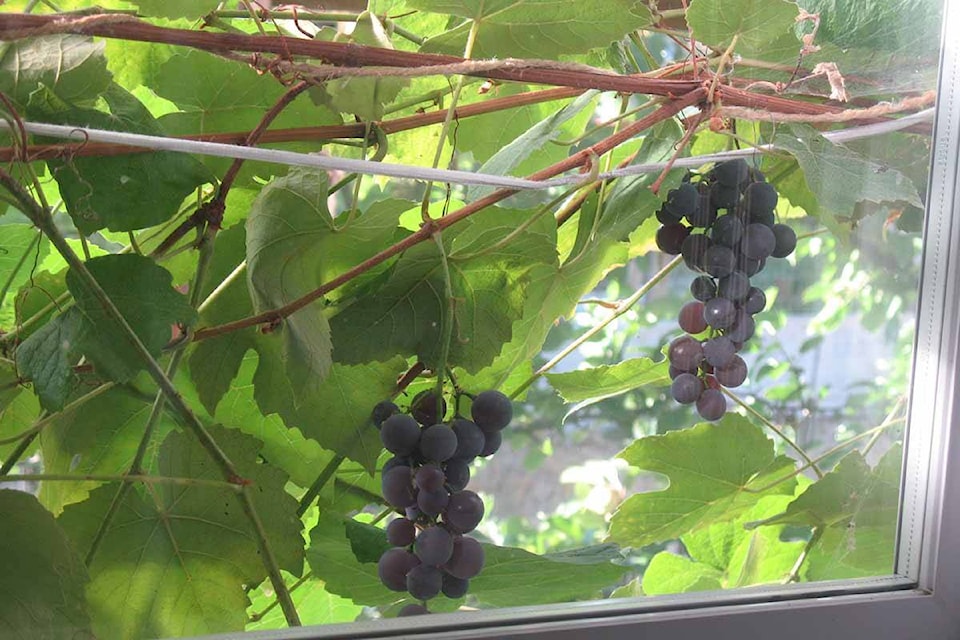By Mary Lowther
According to the Sunset book on How to Grow Fruits, Nuts and Berries, “Grapes are extremely distinctive for the fact that skilled tasters often can identify the source of wines from them, sometimes down to the exact patch of ground, by flavour alone.” Wikipedia reveals that this is a bankable skill, as oenologists earn a median income above $61,000 annually. Those interested in a career change can earn a degree at Brock University, assuming their sensitive noses can endure the ambience of St. Catherines, Ontario.
This nondrinker can’t tell one vintage from another but I do like my grapes, even the ones that dry on the vine like two I had yesterday. In fact, if we hadn’t already eaten all the rest as they ripened I would save them for raisins; obviously we need more vines, and more time. We planted three varieties seven years ago. It doesn’t seem that long but I kept the receipt from Dinter’s (nursery) and recorded it in my journal. We bought black buffalo, red flame and interlaken, planted them in a greenhouse on the south side of our house and two years later began harvesting delicious grapes.
Now, however, we are moving to a larger garden and I want to take them with me, which poses a propagation problem. I know about the birds and bees, but mother never explained how seedless grapes reproduce. She never actually explained how humans reproduce, either, but I worked it out through research and experimentation, and confidently expect I can do grapes with a lot less physical inconvenience and laundry.
Evidently, there are several ways to propagate grape vines. I’m going to try the one that looks easiest for beginners: hardwood cuttings. Bernd Maier of the New Mexico State University suggests taking 14 to 16 inch cuttings with three or more buds from a vine during the dormant season after the leaves have fallen off, cutting the bottoms flat and the tops on a slant to differentiate top from bottom. Wrap the cuttings in dampened sawdust or coir inside plastic wrap, roll them up, label and store in a cold place. Just before springtime soak the cuttings for several hours before planting. I intend to pot them up, keep them in a sunny area, water them regularly and plant them out the following year. We’ll also save some time by buying a few more established plants.
Grapes are easy to grow, don’t require much room since they climb a trellis and are happy with minimal maintenance. I give them some organic fertilizer twice during the growing season, sprinkle compost tea on them every two weeks or so and water them with a soaker hose for half an hour twice a week. They grow on wires along the sunny side of the house, and I’ve trained one vine to cross the bathroom window outside, hoping it would develop a bunch of grapes there. It did, and David wants to pick them, but I told him these are for look, not eat. Not yet, anyway.
We had a variety called Muscat when we lived in Victoria that wasps found as tasty as we did. They’d eat their way inside the unpicked grapes and then drop straight to the floor when they were either full or drunk, perhaps both. They didn’t eat much of the harvest and were pretty funny to watch. Here in Mesachie, they haven’t bothered our grapes (so far) so I am assuming that they prefer the cabbage moth larvae; David thinks they may have entered a 12 step program. Either way we have had the grapes to ourselves.
Lucius Julius Columella wrote about growing grapes in Roman times citing Egyptian methods and today some lucky apartment dwellers in Italy need only to reach out their windows to pick a bunch from vines that have grown up from the ground, right up the whole side of the building. Given that grape vines can live between 50 and 100 years, the grapes these folks are eating may have been planted before the First World War. It’s nice to think that my grandchildren could be still eating from our vines when we’re pushing up daisies, or in David’s case, stinkwort.
Please contact mary_lowther@yahoo.ca with questions and suggestions since I need all the help I can get.
